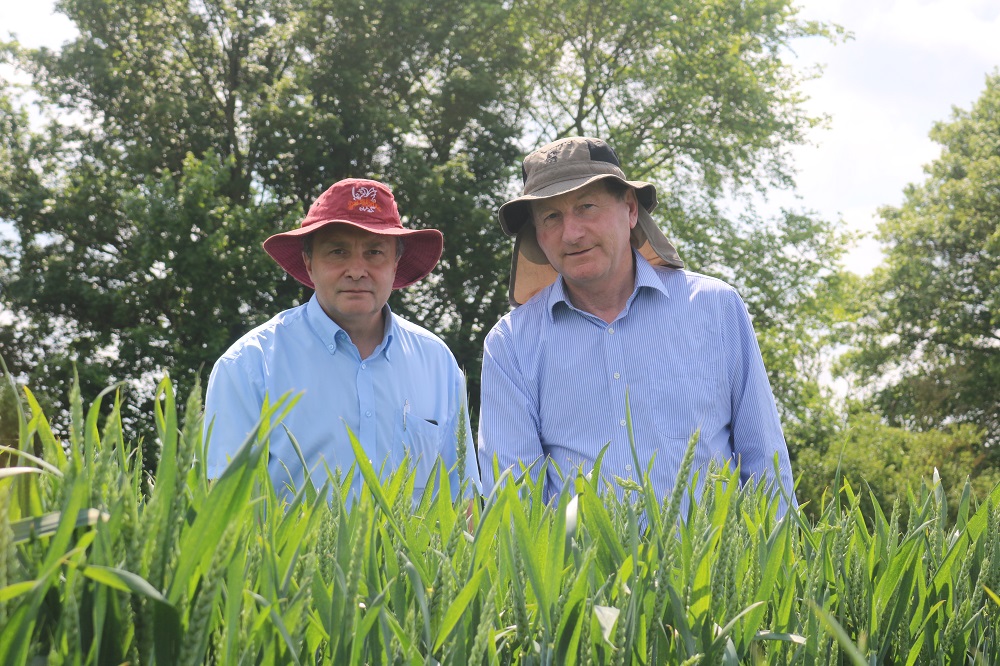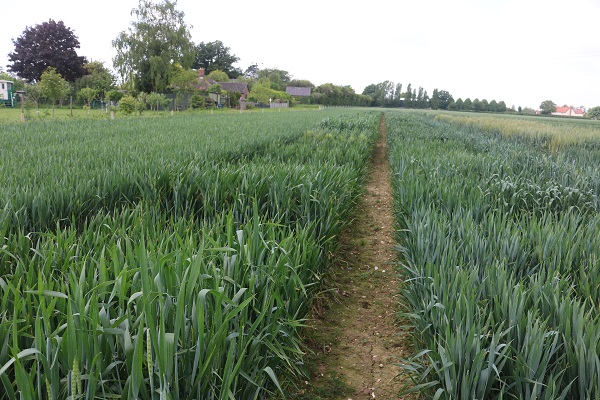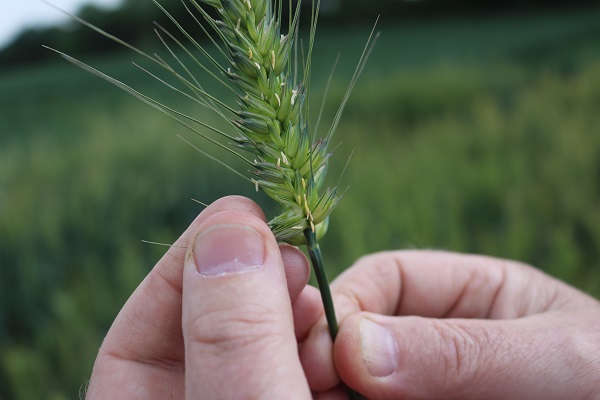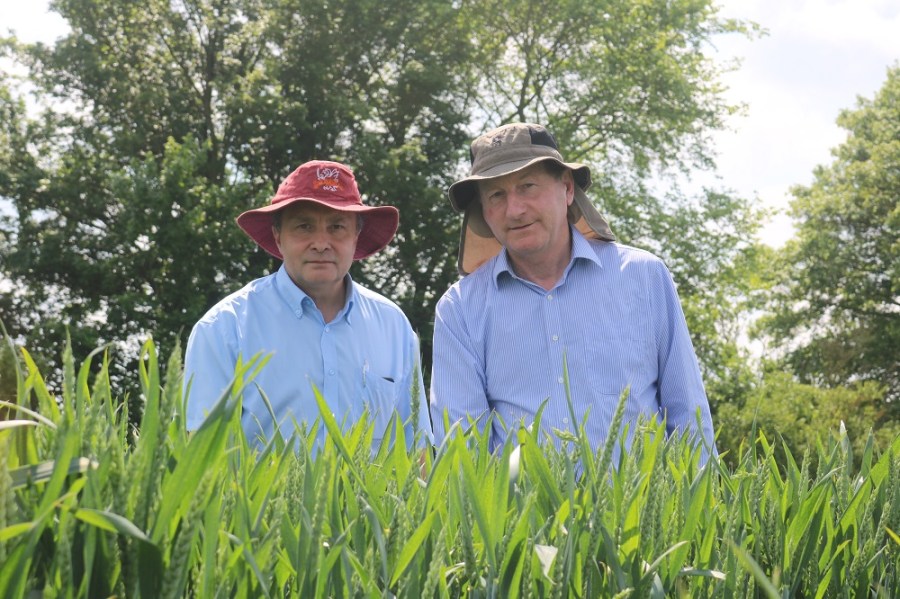
One of Britain’s leading wheat breeders is pioneering the parent lines of Bayer’s UK hybrid wheat programme. CPM visits the plots for an insight into what’s in store.
Hybrids are consistent performers, both in terms of yield and grain quality, but finding the right genetics is a massive task.
By Tom Allen-Stevens
Bill Angus behaves somewhere between a parent and a headmaster as he moves among the plots of wheat laid out like a mosaic in a 5.5ha field near Woolpit, Suffolk. Every wheat has its own character and peculiar nature that should be identified and nurtured, it seems.
“We’re developing some really good genetic material,” he says. “I’m really pleased with how quickly it’s coming along.”

In truth, there’s a jumble of genetics spread out across these microplots. While a grower would be appalled at the inconsistency of performance across the field, for the breeder it’s this very diversity that lies at the heart of discovery. These misshapen oddities probably hold the key that will unlock the next generation of UK wheats.
We stop by one plot that’s engulfed in yellow rust, for example. “You see, that’s excellent,” enthuses Bill Angus. “It tells me so much about how this line, and more importantly its parents, behave.” Nearby, there’s a spindly looking wheat that’s nearly completed flowering before the rest of the field has even begun. And he stoops to inspect the progress of one small plot of a double-dwarf wheat.
But then there are other seemingly majestic lines trailing huge flag leaves – while you’d think they’d be treasured, they’re summarily dismissed. “No, that’s of little value to me.”

What he’s aiming to develop is variability. This is the breeding ground of the parent material for Bayer’s UK hybrid wheat programme. Bill Angus is identifying and developing the male and female lines that will be crossed and eventually sold to growers as commercial F1 hybrids.
“The naïve view of breeding is that you take the highest yielder, cross it with the second highest yielder, and you get the perfect wheat. That often doesn’t happen, because the two lines are often too closely related,” he explains.
Even conventional wheat breeding he describes as “too incestuous” – the pursuit of a narrow set of field-performance factors has led modern breeders to focus efforts on wheats with a similar parentage, he feels, all descended from very few varieties.
“The trick in hybrid breeding is heterosis, or hybrid vigour – you’re aiming to develop and combine very different genetic pools. When they come together, the result can be a hybrid that can better overcome the limitations that hold back conventional wheats.” Example target areas in the UK for hybrid wheat would be brashy soils, high altitude sites or second wheat situations. Varieties with an earlier harvest date would be of value in the North.
“Hybrids are consistent performers, both in terms of yield and grain quality, and do particularly well in more marginal situations. But finding the right genetics is a massive task – it’s the Holy Grail of wheat breeding and what any serious breeder wants to do. So if someone comes along and offers you that chance, you’re not going to turn it down.”
For Bill Angus, this has been something of a 40-year journey. He joined the Plant Breeding Institute (PBI) just outside Cambridge in 1973, which at the time dominated the UK wheat-breeding industry. “When I left university, I could barely tell the difference between wheat and barley, but I did my apprenticeship under John Bingham. With him, you didn’t just learn plant breeding, you imbibed it. It was an unparalleled apprenticeship – a life changing experience.”
By the mid-1980s, with PBI moving towards privatisation, private-sector breeders were rising in prominence, and he moved to Nickersons in 1984. “The company was obsessed with hybrid wheat. I went there because I thought there’d be a treasure trove of genetic material to work with. But the cupboard was pretty much bare.”
What they did have was quite different from the PBI wheats, however. Nickersons’ wheat-breeding station moved from Rothwell in Lincs to Woolpit and Bill Angus worked on lines that eventually resulted in the mainstay Group 3 variety Claire, that’s earned more in royalties than any other UK wheat in history. Other giants, such as Einstein and Istabraq and more recently Crusoe came from the same stable.
But this was still very much a conventional wheat programme, and remained so after Limagrain bought the company in 1990. Bill Angus left to start up on his own in 2012, and this gave him the opportunity to explore more diverse genetic pools. “Funding for hybrids, especially in the private sector, has always been tight. You need a global vision and a different mindset to make it work.”
That’s where Bayer comes in. Apart from a few oilseed rape hybrids, the company’s not known in the UK as a breeder of note, and doesn’t yet have a commercial wheat variety. But this is set to change.
Globally, Bayer spends over €300M/year on R&D in seeds and traits (see panel below). It’s the biggest breeder of hybrid OSR in Canada and the US, with around 4M hectares in Canada alone, and has a sizeable share of the market across Asia and Australia. It’s a global leader in hybrid rice, has a significant hybrid vegetable division and develops traits for maize (although Bayer doesn’t sell maize seed).
Wheat presents a different challenge, however, explains Bill Angus. “OSR, maize, and even barley naturally out-pollinate. But for thousands of years, we’ve developed wheat that doesn’t. Wheat pollen is also very heavy – it drops like a stone and won’t travel far.”
So to create hybrids you need male-sterile lines which are the females and good males to create the pollen cloud to effect fertilisation. In barley and maize, cytoplasmic male sterility has existed for decades, and is a trait that has now been readily bred into commercial female parent lines. But in wheat, such technology is a new development. Until now, male sterility has been delivered to female parents through chemical hybridising agents (CHA), such as Croisor. Licensed in only a few countries and expensive, this must be timed precisely, and only half the field produces the F1 hybrid seed you’re after.
Then there’s the male lines needed to provide the pollen. “You can make a female out of virtually anything. But good males are as rare as hen’s teeth,” says Bill Angus.
“Ideally the male should flower slightly on the late side. For females, the stigma needs to become receptive at the same time as the pollen is available. The lodicules at the base of the ovary swell with water and the glumes open up – that’s when the plant is at its most receptive and this should coincide with when the males release their pollen. Just like breeding improved disease resistance, we can carry out a similar strategy for improving male and female characters.”
The males should also be a little taller than the females to allow the best chance for fertilisation as the pollen falls. “With hybrid seed we need to get the seed cost down. That means raising the hybrid production level in the field, which has a lot to do with the choice of male lines.”
So while the male lines are chosen mainly for their pollen prowess, Bill Angus is on the look-out for other interesting traits for the female candidates. And in a European context, the French varieties dominate. “If you cross a French female with a UK male, you’ll get a French hybrid. That’s because their varieties possess inherent genetic phenology traits which just happen to be dominant.
“Conventional UK varieties have been bred using genetic resources from around the world and we need to tap into this when developing hybrids. The UK has some of the best breeding material and programmes in the world. We’re also brilliantly funded by public research and there’s freedom of access to genetic material. Our wheat research beats everyone else in the world.”
And it’s the fruits of much of this, as well as other material, that Bill Angus has gathered together into his 5.5ha of microplots. And it may well be one of these awkward and incongruous lines that parents the next Mercia, or Claire, Skyfall, or even cracks the conundrum of wheat-based problems we currently can’t consider could be beaten.
Technology complements the breeder’s eye
Bayer’s hybrid wheat programme has been running for around three years, but don’t expect material to hit the UK market until after 2020, says UK seed manager Adrian Cottey. Once it does, however, get ready for wheat to take a step change in performance.
“Initially growers will be exposed to continental hybrids but then we expect to see the first of those bred from the UK programme two or three years later,” he says.
The hybrid wheat market is more developed in Europe, and Bayer’s continental programme operates from Gatersleben in Saxony, Germany and Milly-la-Forêt, near Paris in France. “Central and Southern Europe generally has more challenging wheat-growing conditions than maritime UK, which is where hybrids come into their own,” he explains.
Bayer hybrids bred using a CHA are in their third year of testing. “But these are experimental tools to us, so we can understand how parents combine to create hybrids better. We have our own hybrid technology – a genetic sterility system which allows seed to be produced from a more efficient mixed sowing of males and females. The system works in small plots and now we are expanding the testing into bigger plots.”
The technology ensures that the female parent lines in the breeding programme are male-sterile and will therefore cross-pollinate with the pollen-producing male lines. While Bill Angus’ first priority is to feed male parents into Bayer’s breeding programme, the first few females are now being developed in Germany. After the male-sterility is crossed in, it then takes 4-5 years until it’s ready for commercial F1 hybrid seed production, explains Adrian Cottey.
“We’re also using marker-assisted technology and doubled-haploid techniques to speed up the breeding process. But all that does is help us throw away faster what we don’t want. We need to start with the right material, and finding that is still an art that technology can’t fully replace. What Bill provides from field observation in a low-tech way, we can then put into a hi-tech world.”
The skill provided is phenotyping – spotting in the field the traits that will prove interesting when crossed into an eventual F1 hybrid, or traits that are helpful to hybridisation itself. “Even phenotyping will benefit from an element of digitisation. With the right technology such as a drone overflying microplots, you can pick up all sorts of information even the eye of a trained breeder can’t see. But you still need to determine what elements from the data you gather are actually useful.”
In parallel with its hybrid wheat development, Bayer is looking to bring in new traits. This genotyping area of plant breeding has taken a step change with new plant breeding innovations, further informed through mapping of the wheat genome. Such gene-editing is set to open new horizons. “Our intention is to use all the genetic tools available to us, if they make sense and are acceptable to the market,” continues Adrian Cottey.
“But we have to work out what we’re aiming to achieve first. Then it’s a case of determining whether it’s a trait that needs to be transferred in, or whether we can adapt existing lines. At the end of the day, we’re still trying to do what breeders have always done – we just have a more detailed understanding of the material we’re working with that helps us focus, and more tools in the toolbox to speed things up,” he says.




